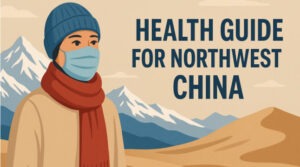The vast lands of Northwest China — from the deserts of Xinjiang to the mountains of Gansu and the high plateaus of Qinghai — are breathtaking but also harsh. Freezing winters, dry air, and high-altitude lifestyles challenge the body in unique ways. This Preventive Healthcare Guide for People Living in Northwest China blends traditional wisdom and modern medical insights to help residents thrive in this demanding environment.

Why Preventive Health Is Crucial in Northwest China
Northwest China faces distinct public health challenges due to its geography and climate:
Translate to your Favourite language & Read

- Extreme temperature shifts cause cardiovascular strain.
- Low humidity and high dust levels irritate lungs and skin.
- High-altitude regions like Qinghai increase risk of hypoxia and hypertension.
- Diet patterns high in salt, fat, and red meat contribute to metabolic diseases.
Preventive healthcare helps adapt the body to the region’s environmental stress while reducing chronic disease risks.
1. Heart and Blood Pressure Management
Cold climates and salty diets make hypertension and heart disease prevalent in northwest populations.
Preventive Measures:
- Limit salt intake to under 5 g/day (about one teaspoon).
- Use iodized salt to prevent thyroid issues common in inland areas.
- Maintain indoor warmth but ensure proper ventilation.
- Regular blood pressure checks (at least twice a month).
- Include potassium-rich foods like bananas, beans, spinach, and mushrooms.
2. Respiratory Health in Dusty & Dry Conditions
Sandstorms and low humidity can cause chronic bronchitis, sinusitis, and asthma-like symptoms.
Protect Your Lungs:
- Use N95 masks during high dust days.
- Install humidifiers indoors to maintain 40–60% humidity.
- Stay hydrated — aim for 2.5–3 liters of water daily.
- Include pear, honey, and tremella mushroom soups — traditional remedies that soothe the respiratory tract.
- Avoid indoor smoking and open coal heating without ventilation.
Tip: Local herbal teas like Licorice-Ginger infusion (Gan Cao Sheng Jiang) have anti-inflammatory and throat-soothing properties when consumed moderately.
3. Skin and Hydration Care
The dry continental climate dehydrates skin and accelerates aging.
Preventive Routine:
- Use moisturizers with ceramides or glycerin daily.
- Apply SPF 30+ sunscreen, even in winter, to block UV at high altitudes.
- Eat omega-3-rich foods (walnuts, flaxseed oil, fish) for skin elasticity.
- Bathe with lukewarm water — hot water strips natural oils.
Traditional Insight: Tibetan barley (Tsampa) and yak milk are naturally rich in antioxidants that support skin and immunity.
4. Nutrition — Balancing Local Diets
Dietary habits in Northwest China are meat-heavy, often low in fruits and vegetables. Balanced nutrition helps maintain metabolic health.
Healthy Modifications:
- Replace half of red meat with poultry, fish, or legumes.
- Add local vegetables like Chinese cabbage, spinach, and carrots to every meal.
- Reduce refined flour in noodles; try whole wheat or buckwheat versions.
- Limit dairy fat by using low-fat milk or yogurt.
- For vegetarians, include soybeans, tofu, and lentils to ensure protein intake.
A 2023 BMC Nutrition study from Xinjiang confirmed that residents consuming ≥3 servings of vegetables daily had significantly lower rates of metabolic syndrome.
5. Bone and Joint Health in Cold Climate
Low sunlight exposure and long winters cause Vitamin D deficiency, leading to weak bones and joint stiffness.
Prevention:
- Spend 15–20 minutes in sunlight daily, even in cold months.
- Take Vitamin D3 (600–800 IU/day) and Calcium (1000 mg/day) under medical advice.
- Include fish, eggs, and fortified soy milk in your diet.
- Practice stretching and low-impact exercise (like brisk walking or Tai Chi) indoors.
Fun fact: Local dishes like stewed lamb bone soup provide collagen and minerals beneficial for joint health when consumed in moderation.
6. Altitude and Oxygen Adaptation (For High-Plateau Regions)
At high altitudes (e.g., Qinghai, parts of Xinjiang), oxygen levels are 20–30% lower than at sea level.
Preventive Strategies:
- Gradual acclimatization — increase altitude exposure over 3–5 days.
- Avoid alcohol and smoking, which reduce oxygen uptake.
- Eat iron-rich foods (red beans, liver, leafy greens).
- Stay hydrated — dehydration worsens altitude symptoms.
- Consult a doctor about iron or B12 supplements if fatigue or dizziness persists.
7. Mental Health and Social Wellness
Isolation and extreme weather can increase anxiety or seasonal depression.
Protective Habits:
- Maintain daily social contact, even virtually.
- Get natural light exposure or use a daylight lamp in dark winters.
- Practice mindful breathing or Tai Chi to reduce stress.
- Seek professional help early — many provincial health centers now offer tele-counseling.
Cultural strength: Community gatherings and traditional dance in Xinjiang and Gansu foster emotional resilience — social bonding is preventive medicine.
8. Preventive Screenings
Every adult in Northwest China should prioritize:
- Blood sugar and lipid profile (annually)
- Blood pressure and weight monitoring (monthly)
- Liver function (especially for those consuming alcohol or high-fat diets)
- Eye checkups (UV exposure at altitude increases cataract risk)
- Dental care (dry air promotes oral dryness and gum disease)
Free screenings under the Healthy China 2030 policy are available through local clinics and township health centers.
Verdict: Adaptation Is Prevention
Northwest China’s environment tests human resilience — but with the right lifestyle adaptations, the body can thrive.
The keys are hydration, balanced diet, sun exposure, respiratory protection, and social connection.
Health here isn’t about fighting nature — it’s about living in rhythm with it.
References
- Peng, Wen, et al. “Trends in major non-communicable diseases and related risk factors in China 2002–2019: an analysis of nationally representative survey data.” The Lancet Regional Health–Western Pacific 43 (2024).
- Niu, Fang, and Xiang Wang. “Psychological well-being of rural left-behind women in Northwest China and its associated factors: a regional, population-based study.” Frontiers in Public Health 12 (2024): 1395996.
- Chen, Kexin, et al. “Identification and analysis of influencing factors of multidimensional health poverty in rural areas of Northwest China.” Scientific Reports 14.1 (2024): 28952.
Leave a Reply